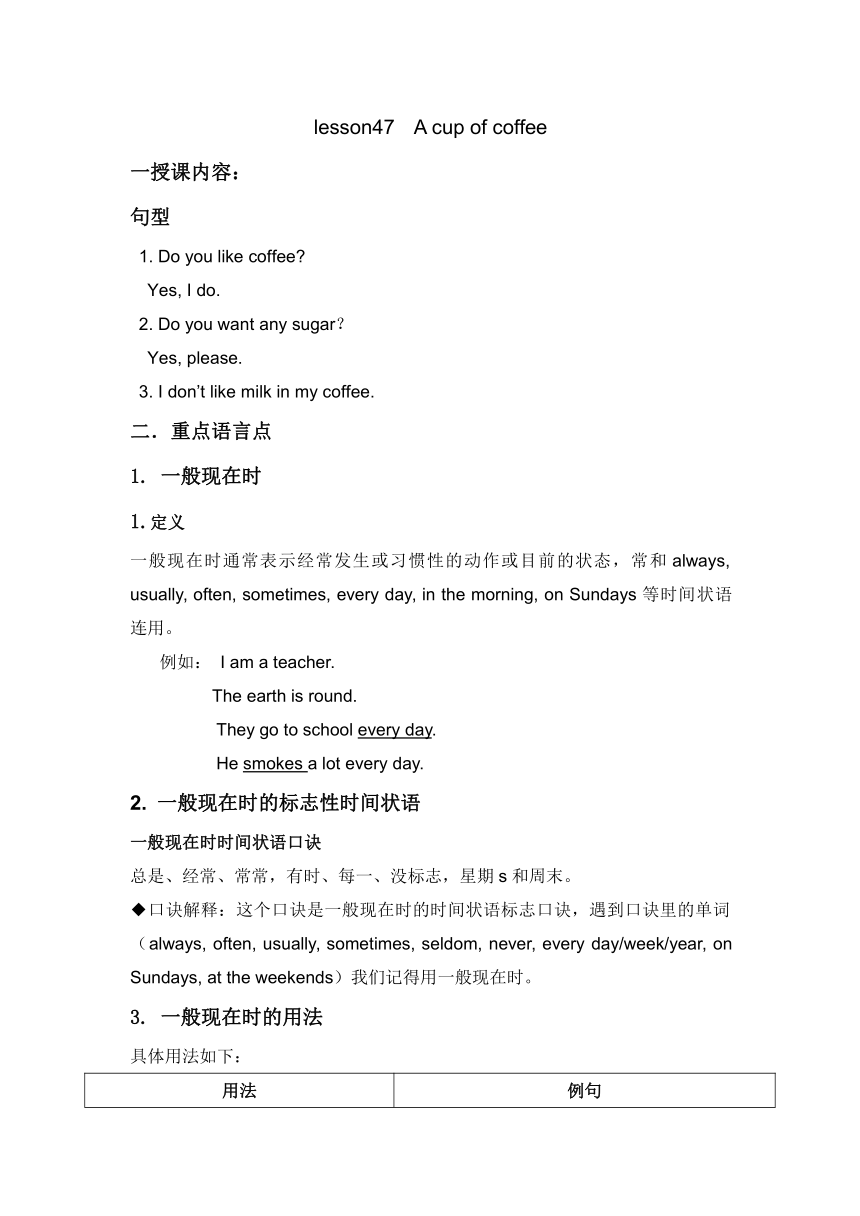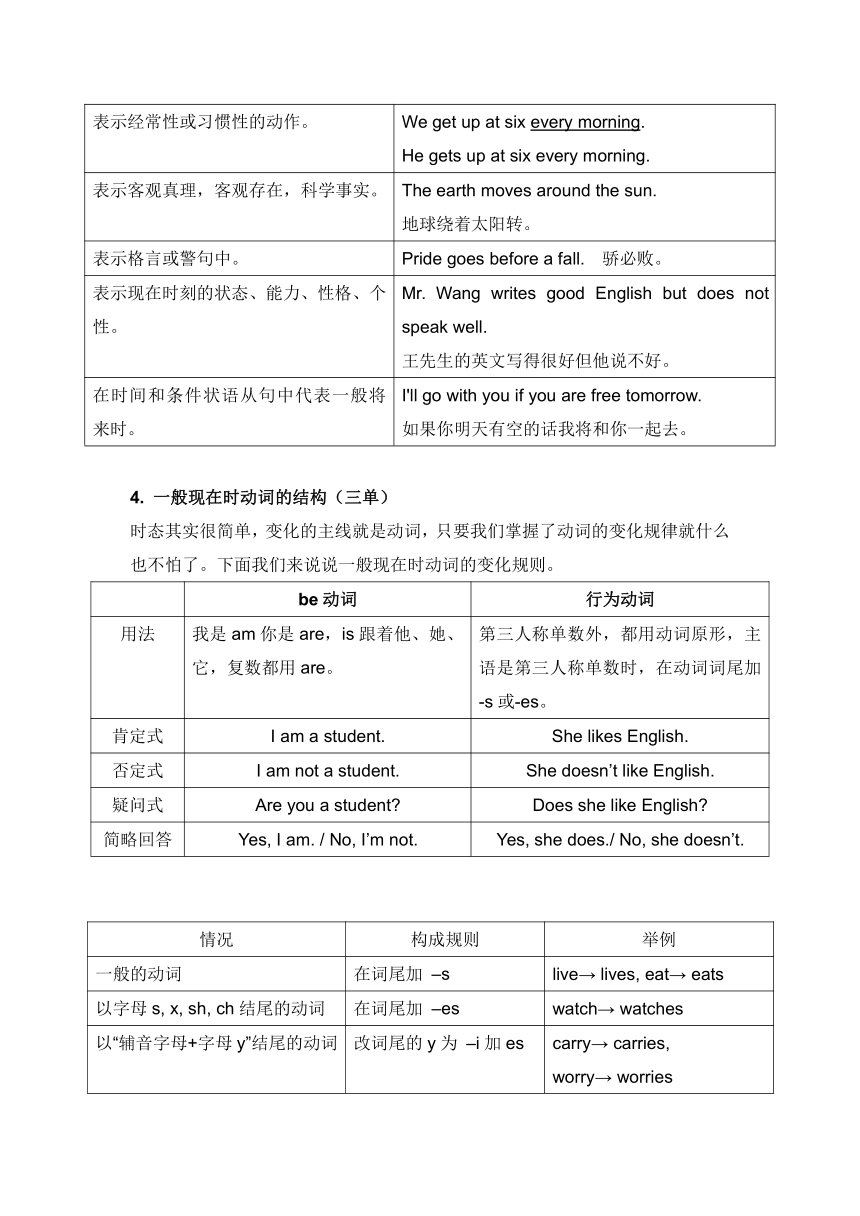新概念第一册讲义Lesson 47 A cup of coffee(无答案)
文档属性
| 名称 | 新概念第一册讲义Lesson 47 A cup of coffee(无答案) |  | |
| 格式 | docx | ||
| 文件大小 | 21.5KB | ||
| 资源类型 | 教案 | ||
| 版本资源 | 新概念英语 | ||
| 科目 | 英语 | ||
| 更新时间 | 2024-01-21 16:24:54 | ||
图片预览


文档简介
lesson47 A cup of coffee
一授课内容:
句型
1. Do you like coffee
Yes, I do.
2. Do you want any sugar?
Yes, please.
3. I don’t like milk in my coffee.
二.重点语言点
1. 一般现在时
1.定义
一般现在时通常表示经常发生或习惯性的动作或目前的状态,常和always, usually, often, sometimes, every day, in the morning, on Sundays等时间状语连用。
例如: I am a teacher.
The earth is round.
They go to school every day.
He smokes a lot every day.
2. 一般现在时的标志性时间状语
一般现在时时间状语口诀
总是、经常、常常,有时、每一、没标志,星期s和周末。
◆口诀解释:这个口诀是一般现在时的时间状语标志口诀,遇到口诀里的单词(always, often, usually, sometimes, seldom, never, every day/week/year, on Sundays, at the weekends)我们记得用一般现在时。
3. 一般现在时的用法
具体用法如下:
用法 例句
表示经常性或习惯性的动作。 We get up at six every morning. He gets up at six every morning.
表示客观真理,客观存在,科学事实。 The earth moves around the sun. 地球绕着太阳转。
表示格言或警句中。 Pride goes before a fall. 骄必败。
表示现在时刻的状态、能力、性格、个性。 Mr. Wang writes good English but does not speak well. 王先生的英文写得很好但他说不好。
在时间和条件状语从句中代表一般将来时。 I'll go with you if you are free tomorrow. 如果你明天有空的话我将和你一起去。
4. 一般现在时动词的结构(三单)
时态其实很简单,变化的主线就是动词,只要我们掌握了动词的变化规律就什么也不怕了。下面我们来说说一般现在时动词的变化规则。
be动词 行为动词
用法 我是am你是are,is跟着他、她、它,复数都用are。 第三人称单数外,都用动词原形,主语是第三人称单数时,在动词词尾加-s或-es。
肯定式 I am a student. She likes English.
否定式 I am not a student. She doesn’t like English.
疑问式 Are you a student Does she like English
简略回答 Yes, I am. / No, I’m not. Yes, she does./ No, she doesn’t.
情况 构成规则 举例
一般的动词 在词尾加 –s live→ lives, eat→ eats
以字母s, x, sh, ch结尾的动词 在词尾加 –es watch→ watches
以“辅音字母+字母y”结尾的动词 改词尾的y为 –i加es carry→ carries, worry→ worries
特殊变化 没有统一的规则 have → has, do-does, go-goes
关于行为动词在一般现在时中,当句子的主语是第三人称单数时,具体变化规律如下:
一般现在时句型转换
肯定句变否定句,陈述句变一般疑问句
含有be动词和情态动词的肯定句变否定句,陈述句变一般疑问句
含be动词的肯定句变否定句,直接在be动词后加not
含有be动词的陈述句变一般疑问句,把be动词提到句首,首字母大写,句末加问号。如果有第一人称,需要把第一人称变成第二人称,如果句中有some把some变成any
This is my book.
This is not my book.
Is this your book
含有实意动词肯定句变否定句,陈述句变一般疑问句
含有实意动词的肯定句变否定句
1.如果句子的主语是非第三人称单数,在动词前加don’t。
I like noodles.
I don’t like noodles.
2. 如果句子的主语是第三人称单数,在句首加Does,动词的第三人称单数形式恢复成原型,句末加问号。
Danny likes noodles.
Danny doesn’t like noodles.
含有实意动词肯定句变否定句,陈述句变一般疑问句
1.如果句子的主语是非第三人称单数,在句首加Do,句末加问号。
I see a goat.
Do you see a goat
2. 如果句子的主语是第三人称单数,在句首加Does,动词的第三人称单数形式恢复成原型,句末加问号。
Danny likes noodles.
Does Danny like noodles
三、课堂练习
写出以下动词的三单形式
do ________ have ________ like ________ want ________
go ________ watch________ look________ see________
run________ get________ stand________ feel________
用动词的适当形式填空
Danny ________(want) a cup of coffee.
________ (look) at the picture.
I can ________(see) a bird in the tree.
I ________(walk) to school everyday.
My father ________(drive) to work everyday.
把下面的陈述句分别变成否定句和一般疑问句。
This is a pen.
否定句: _____________________________________________
一般疑问句:__________________________________________
The boy under the tree is Tom.
否定句:______________________________________________
一般疑问句:__________________________________________
I am good at singing.
否定句:_____________________________________________
一般疑问句:__________________________________________
My father is an English teacher.
否定句: ______________________________________________
一般疑问句:__________________________________________
Our teacher is drinking some water now.
否定句:_____________________________________________
一般疑问句:_________________________________________
I like to read English.
否定句:__________________________________________
一般疑问句:_______________________________________
6. My father goes to work by bus.
否定句:___________________________________________
一般疑问句:_______________________________________
7. Mrs. Li and Kitty watch television at night.
否定句:___________________________________________
一般疑问句:________________________________________
一授课内容:
句型
1. Do you like coffee
Yes, I do.
2. Do you want any sugar?
Yes, please.
3. I don’t like milk in my coffee.
二.重点语言点
1. 一般现在时
1.定义
一般现在时通常表示经常发生或习惯性的动作或目前的状态,常和always, usually, often, sometimes, every day, in the morning, on Sundays等时间状语连用。
例如: I am a teacher.
The earth is round.
They go to school every day.
He smokes a lot every day.
2. 一般现在时的标志性时间状语
一般现在时时间状语口诀
总是、经常、常常,有时、每一、没标志,星期s和周末。
◆口诀解释:这个口诀是一般现在时的时间状语标志口诀,遇到口诀里的单词(always, often, usually, sometimes, seldom, never, every day/week/year, on Sundays, at the weekends)我们记得用一般现在时。
3. 一般现在时的用法
具体用法如下:
用法 例句
表示经常性或习惯性的动作。 We get up at six every morning. He gets up at six every morning.
表示客观真理,客观存在,科学事实。 The earth moves around the sun. 地球绕着太阳转。
表示格言或警句中。 Pride goes before a fall. 骄必败。
表示现在时刻的状态、能力、性格、个性。 Mr. Wang writes good English but does not speak well. 王先生的英文写得很好但他说不好。
在时间和条件状语从句中代表一般将来时。 I'll go with you if you are free tomorrow. 如果你明天有空的话我将和你一起去。
4. 一般现在时动词的结构(三单)
时态其实很简单,变化的主线就是动词,只要我们掌握了动词的变化规律就什么也不怕了。下面我们来说说一般现在时动词的变化规则。
be动词 行为动词
用法 我是am你是are,is跟着他、她、它,复数都用are。 第三人称单数外,都用动词原形,主语是第三人称单数时,在动词词尾加-s或-es。
肯定式 I am a student. She likes English.
否定式 I am not a student. She doesn’t like English.
疑问式 Are you a student Does she like English
简略回答 Yes, I am. / No, I’m not. Yes, she does./ No, she doesn’t.
情况 构成规则 举例
一般的动词 在词尾加 –s live→ lives, eat→ eats
以字母s, x, sh, ch结尾的动词 在词尾加 –es watch→ watches
以“辅音字母+字母y”结尾的动词 改词尾的y为 –i加es carry→ carries, worry→ worries
特殊变化 没有统一的规则 have → has, do-does, go-goes
关于行为动词在一般现在时中,当句子的主语是第三人称单数时,具体变化规律如下:
一般现在时句型转换
肯定句变否定句,陈述句变一般疑问句
含有be动词和情态动词的肯定句变否定句,陈述句变一般疑问句
含be动词的肯定句变否定句,直接在be动词后加not
含有be动词的陈述句变一般疑问句,把be动词提到句首,首字母大写,句末加问号。如果有第一人称,需要把第一人称变成第二人称,如果句中有some把some变成any
This is my book.
This is not my book.
Is this your book
含有实意动词肯定句变否定句,陈述句变一般疑问句
含有实意动词的肯定句变否定句
1.如果句子的主语是非第三人称单数,在动词前加don’t。
I like noodles.
I don’t like noodles.
2. 如果句子的主语是第三人称单数,在句首加Does,动词的第三人称单数形式恢复成原型,句末加问号。
Danny likes noodles.
Danny doesn’t like noodles.
含有实意动词肯定句变否定句,陈述句变一般疑问句
1.如果句子的主语是非第三人称单数,在句首加Do,句末加问号。
I see a goat.
Do you see a goat
2. 如果句子的主语是第三人称单数,在句首加Does,动词的第三人称单数形式恢复成原型,句末加问号。
Danny likes noodles.
Does Danny like noodles
三、课堂练习
写出以下动词的三单形式
do ________ have ________ like ________ want ________
go ________ watch________ look________ see________
run________ get________ stand________ feel________
用动词的适当形式填空
Danny ________(want) a cup of coffee.
________ (look) at the picture.
I can ________(see) a bird in the tree.
I ________(walk) to school everyday.
My father ________(drive) to work everyday.
把下面的陈述句分别变成否定句和一般疑问句。
This is a pen.
否定句: _____________________________________________
一般疑问句:__________________________________________
The boy under the tree is Tom.
否定句:______________________________________________
一般疑问句:__________________________________________
I am good at singing.
否定句:_____________________________________________
一般疑问句:__________________________________________
My father is an English teacher.
否定句: ______________________________________________
一般疑问句:__________________________________________
Our teacher is drinking some water now.
否定句:_____________________________________________
一般疑问句:_________________________________________
I like to read English.
否定句:__________________________________________
一般疑问句:_______________________________________
6. My father goes to work by bus.
否定句:___________________________________________
一般疑问句:_______________________________________
7. Mrs. Li and Kitty watch television at night.
否定句:___________________________________________
一般疑问句:________________________________________
同课章节目录
